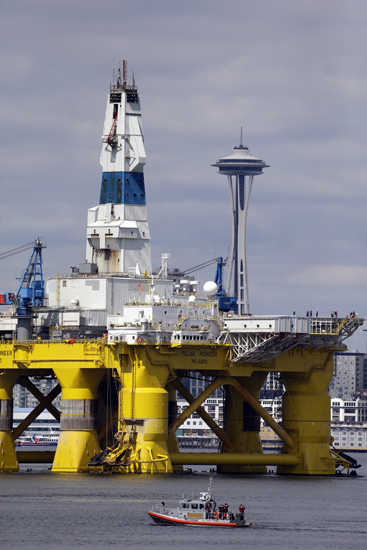ANCHORAGE — Royal Dutch Shell is parking two massive Arctic oil drilling rigs in Seattle’s waterfront before they head north. The first drill rig, the Polar Pioneer, arrived in Seattle waters on Thursday, with the other — the Noble Discoverer — at a nearby port awaiting transit.
Here’s a look at the debate over Shell’s plans to drill in the Arctic:
How much fuel is at stake?
The U.S. Geological Survey estimates Arctic offshore reserves at 26 billion barrels of recoverable oil and 130 trillion cubic feet of natural gas.
Shell says developing these reserves could increase domestic oil supplies by more than 1 million barrels a day.
Shell has already spent nearly $7 billion in preparing to recover this oil, and plans to drill up to four exploratory wells over two years in the Chukchi Sea to determine whether there are commercial quantities of oil and gas.
Why is Shell preparing its rigs in Seattle and not Alaska?
Alaska doesn’t have the infrastructure in place to stage Shell’s Arctic fleet.
Shell stored equipment in Seattle for the 2012 drilling season and again wants to use its deep-water port, loading space and workforce to load drilling rigs and the accompanying fleet with supplies and personnel. Seattle provides not only a port but also facilities to load pipe, drilling mud and everything else needed for a complex underwater drilling operation.
Why are conservation groups opposed?
People concerned with a warming planet object to additional fossil fuel development. They worry that industrial development and a catastrophic spill would ruin a fragile region far from responders.
Environmental groups contend the oil industry has never demonstrated companies can clean up a major spill in water choked with ice. The Arctic is more than 1,000 miles from the nearest Coast Guard base. The northern Alaska coastline lacks deep-water ports, major airports and the most basic infrastructure for spill responders.
The Arctic Ocean’s open-water season begins in July and closes a few months later in cold, dark, conditions with some of the most treacherous storms on the planet.
How do Alaskans feel about Arctic offshore drilling?
State officials welcome drilling. Alaska receives upward of 90 percent of its revenue from the oil industry, and a drop in capacity or a dip in crude oil prices can mean multi-billion dollar state government deficits. Alaska is experiencing both.
Though Shell is drilling in federal waters, Alaska hopes the federal government will share revenue and that Shell and other companies will transport crude through a pipeline system connected to the trans-Alaska pipeline.
Is exploratory drilling safe?
Shell says yes. Wells would be drilled in the relatively shallow outer continental shelf at three to five times less pressure than the Deepwater Horizon explosion and spill in April 2010, spokesman Curtis Smith said. In the “unlikely” event of a blowout, Smith said, Shell has drilling mud to plug a well, a containment system that could funnel spilled crude to the surface, a second drill rig stationed nearby to drill a relief well and other tools to minimize damage.
Drilling foes says Shell’s 2012 drilling season, which ended with one rig aground off Kodiak and the other fined $12.1 million for breaking maritime law, shows Shell is not prepared to meet Arctic challenges.
What else is needed before shell can drill?
The company cleared a major hurdle on Monday when the U.S. Bureau of Ocean Energy Management approved the company’s multiyear drilling plan. However, it still needs several approvals from state and federal agencies before it can drill.
These include a land-use permit for Goodhope Bay from the state of Alaska. Shell spokesman Curtis Smith says he expects that permit to be issued within the next few weeks. The public comment period on this ended April 30.
Shell also is awaiting a drilling permit from the federal Bureau of Safety and Environmental Enforcement and authorizations related to wastewater discharge from the U.S. Environmental Protection Agency, among others.

